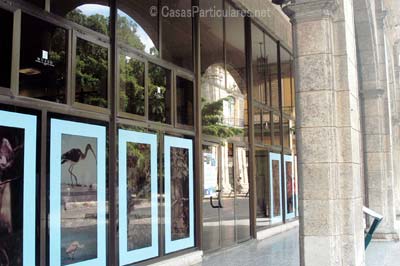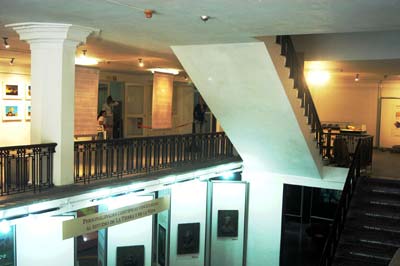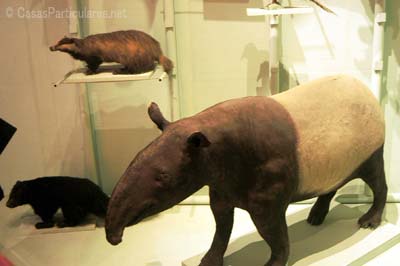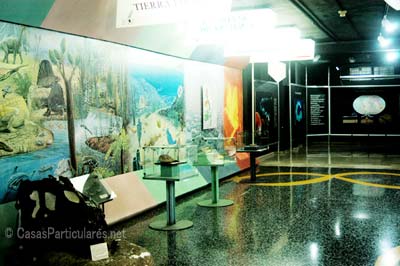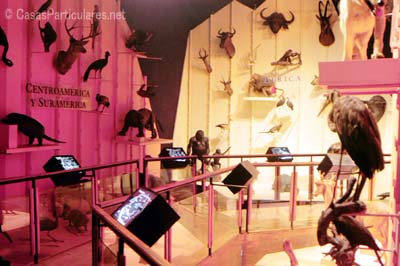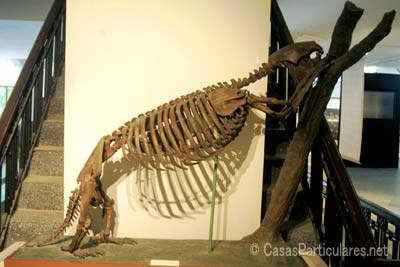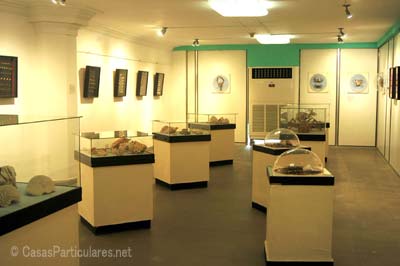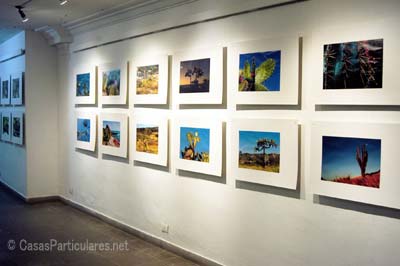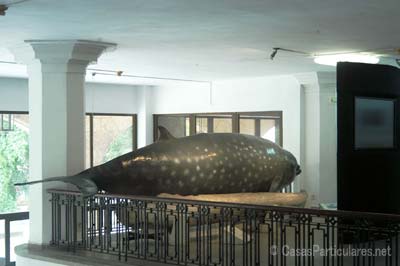The Museum of Nautural History of Cuba
By Claudia Rodriguez Colón, remanied and translated by Danil Ren
Mysteries and Secrets of Cuba Exposed
A place where history takes life and science is at your close reach. A space which satisfies curiosity about natural past, especially the one involved with the origins of Cuba.
The Museum of Natural History of Cuba, summarizes in its exposition halls all the necessary knowledge for people visiting it.
A place where nature is living and make you enjoy with all the mysteries involving the history and the legends of the biggest caribbean island. Awesome animals that lived in Cuba in ancient times and which are only some of the many trearures revealed in this special museum.
Nature has its own History
And, precisely the Museum of Natural History of Cuba, will tell you it, being the result of ideas and brainstorming of many Cuban scientists, who have worked during decades for the creation of a space whose main aim was to entertain with natural sciences. Between its main supporters we must mention Felipe Poey, a key actor in the history of science in Cuba. His scientific work was notable, especially in the ichtyologic studies. Among other things he's the founder of the Royan Academy of Natural, Medical and Fiscal Sciences in Havana.
As a curious fact, the Museum considered several headquarter locations since its inception, one of them was the construction of a building in 23 and L, in the Vedado neighborhood, the now Coppelia ice cream parlor. Another possible place was the building of Asturian Center (now the National Museum of Fines Arts), as well as the pre-university of Old Havana, which was, at that time, the Second Institute of Teaching in Havana, and finally the National Capitolio, which was finally chosen.
On May 26, 1964, the Museum of Natural History opened its gates, but it still had not that name. From its foundation in 1961, and until 1995, it was called The Felipe Poey Science Museum and it was located in the National Capitol.
But, not much later, it took the name it has today and, among its most popular monuments, it features the reproduction in natural scale of the Cave #1 of the East, located in the Youth Island, with lots of impressive autochthonous paintings.
Still during the 90s, after having moved in the current location, the Museum shown interest to engage in international projects; it also amounted an important number of scientific collections.
In 1999, the National Museum of Natural History reopened in Plaza de Armes, which is the current location.
Today, after fifty years of operating, the museum continues to impress either children and adults, with an increasing number of objects to show, as well as the several cultural activities developed by the specialists working there.
Revealed the Unknown
The exposition halls of the National Museum of Natural History are completed by richness of Caribbean history, fossils of extinct animals and a collection of butterflies which are part of wild species in Cuba.
But, apart from revealing unknown things by most people, the 26 exposition halls also invite to enlarge knowledge about nature and inspire respect and the aim to preserve natural values. Each exposition room is about to some data, curiosity or enigma...
The various expositions are divided in several thematic subjects and the first is obviously the Museum From the Inside (El Museo por Dentro), which shows the scientific work made by specialists who have participated in various similar projects in the Caribbean geographic area.
The two floors are made of pure investigation and there you can discover new things, no matter how old you are; they will teach you about the natural history, starting from the dinosaurs era up to now. Several mammals are exposed, as well as reptiles, birds or even embalmed plants, either from Cuba and from the remaining of the world. Most of them extinct, obviously.
The exposition areas are respectively called: The Museum From the Inside, as already mentioned; History of Earth and Life, which shows material about the evolution of the planet until the humans; Mammals, Birds, Reptiles From Other Regions of the World, which specimen classified by geographic area and exposed using museum techniques, such as lights and sounds, which are particularly loved by children; and finally, the Cuban Nature Room an exposition where we can observe minerals from the Island and a great representation of the fauna and the flora that predominate today.
Among the most curious details from History of Earth and Life hall, in the lower floor of the institution, there is an explicative mural with images representing geological ages.
In Mammals, Birds, Reptiles From Other Regions of the World you can also see fossils or replicas of them, and, among them a tyrannosaurus crane, which was famous to be a fierce carnivore.
There is also a skeleton of megalocnus rodens, the giant sloth bear, a mammal now extinct, that lived in Cuba during the quaternary. There are only two specimens of this skeleton, one is located in the museum of the same name in New York, and the other here, in Cuba. The reconstruction was made in the American Institute of New York, using fossils found in 1910 in Cuba, by the Cuban researcher Carlos de la Torre y Huerta.
To learn more about the Cuban giant sloth bear, see this page entirely devoted to the megalocnus rodens.
Among other interesting stuff, it worth to mention a replica of the Earth in movement, as well as the mock-up that instruct about the tectonic plates.
From its side, the Cuban Nature, in the second floor, introduces several collections of Cuban invertebrates and vertebrates, aside from many semiprecious gemstones and fossils of marine reptiles, fishes and dugongs (mammals of the order Sirenia). In the same area, other temporary expositions are shown which demonstrate the beauties of Cuban nature.
Objects of Cultural Heritage
Today, after decades of investigation, the museum could offer several sets of objects which are considered as a part of the cultural national heritage, and they classify from the taxonomic collection to documentary resources.
The first include specimens of minerals, rocks and fossils of animals and plants, which are classified by region and exposed.
The documentary resources are the result of the human creation, for example the investigations associated with the taxonomic collections and other documents about natural history of Cuba in general.
We also have to mention the Colibrí Infantil Hall, where activities for children education take place, especially about the nature and the respect for it.
The museum spaces also include the Video Almiquí Hall, which provides the systematic programming of multimedia material reflecting everything exposed.
One of the most notable areas is the Teacher's Center, associated with the museum showing the work from the staff with intense teaching program.
Not less important is the Miguel L. Jaume specialized library which includes thousand of titles about natural history, nature preservation and other related topics. You'll also find patrimonial documentation, for example, a collection of paints about local and Atlantic side fishes, painted by Otto Siepermann.
Exposing the Future Throughout the Past
The current exhibitions of the Natural History National Museum, collect almost a thousand of specimens, more than 360 texts and 300 showcases, without counting other media.
But, according to the specialists of the place, that's not enough and they are preparing a group of projects which will be installed in several areas of the museum, increasing the number of expositions even more.
One of these new halls will be associated with the biological diversity of Cuba with the greatest possible number of Cuban specimens will be shown, with the aim to change the perception of Cuban nature and its richness, despite that Cuba doesn't have the usual species in woods and jungle, which are common in other zones of the world.
Another project is devoted to Cuban caves, because in Cuba there are thousand of natural caves of various origins, depths and lengths, and they are often considered masterpieces of Nature. This future exposition will also serve as a warning about the extinction dangers hundred of species are risking.
The museum will also add a second infantile hall with the purpose of teaching by amusing about the various methods used to study nature, as well as the development of the necessary natural skills to survive. All this will helps to better understand the Cuban nature.
Amond the future plans, there is also the project to add a thematic hall called Little Giants, devoted to small animals that very often are unnoticed by people and which are considered sometimes even hostile. This project has the aim to educate to see these animals from a different angle. In consequence, they will be exposed alive. The specialists of the museum consider this as a pitfall, because of the maintenance conditions and the need to exhibit living beings, which, in addition, express their way of living.
Another space is devoted to the Woods of Cuba. The goal of this project is to increase awareness about the various vegetal species and promote their protection and safeguard. Plants will be exposed with the purpose to give to the visitors the feeling they are in a Cuban wood, with all its flora.
Another topic will be the corals, because we can't forget that Cuba has the second bigger coral barrier in the world. The purpose is, therefore, to show the biologic diversity inside the barrier and allow to understand the importance of taking care of these ecosystems. For this reason, a naturally scaled reef will be modeled with plants and animal species that live in it.
Cuba: The Real Wonder of a Natural History, is another of the programmed exhibitions which will integrate the natural history of the Cuban territory. Throughout the tectonic plates, some paleographies of the Caribbean Sea will be reconstructed and this will also include Cuba and reference will be made on the most important geological and biological events that have occurred starting from several millions of years ago. This ambitious project will also include animal and geological models that will show the formation of the Cuban archipelago and the evolution of its flora and fauna, from the start to today natural value.
Conclusion
The Museum of Natural History of Cuba opens on Tuesday from 1 to 5 PM and from Wednesday to Sunday from 9:30 AM to 5PM. Closed on Monday. The museum is located in Plaza de Armas, Calle Obispo 61, esquina a Oficios.
The National Museum of Natural History is not the only place where you can learn about natural history of Cuba. To complete this kind of experience, there exist three other centers which also allow you to obtain further knowledge about the topic. One of these places, located in the Plaza Vieja, is the Cámara Oscura (Dark Room), a device which plays with optical illusions and, throughout a system of mirrors, it allows to observe, in real time, the busy life of Old Havana.
Some meters away from that, you can find the Planetarium, a cultural and scientific center which allows the observation of space using a realist model of stars, planets, etc.
Finally, it worth to mention the Belen Observatory, which is also located very close and it occupies the north-east tower of the convent and Nuestra Señora de Belén Church. It features five levels, exposition halls, a multipurpose room, a meteorological station and an astronomic observatory. It's about a modern project which shows the evolution of the meteorology and the climatology of Cuba.
These places and other will be described in other articles our our Essential and Definitive Guide of Old Havana.







